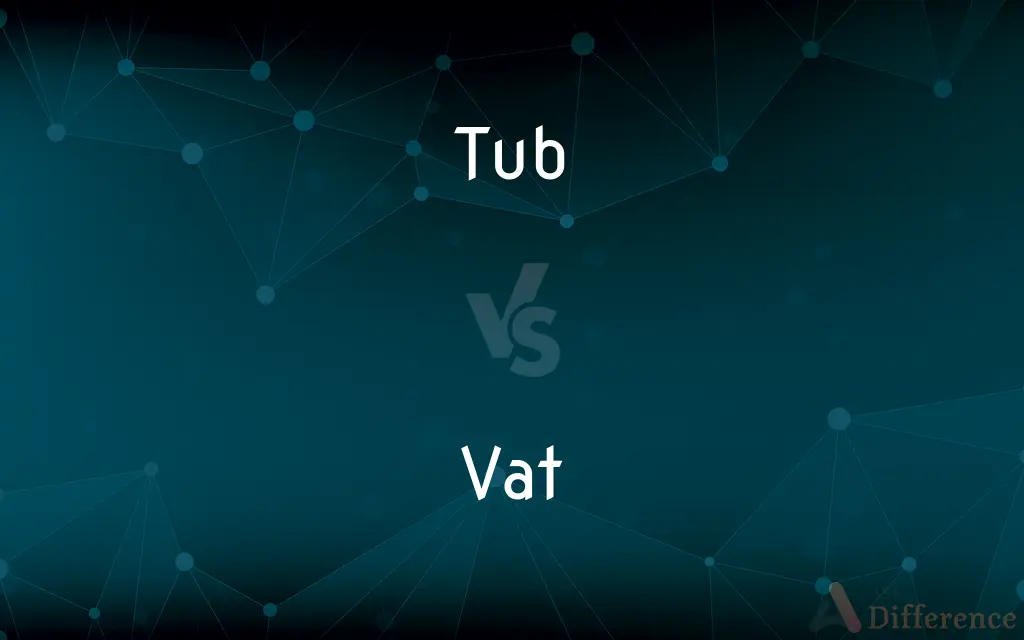Tub vs. Vat — What's the Difference?
By Tayyaba Rehman & Urooj Arif — Updated on April 3, 2024
A tub is often a smaller, wide, open-top container used for bathing or washing, while a vat is a large tank or cistern used for storing or processing liquids in industrial settings.

Difference Between Tub and Vat
Table of Contents
ADVERTISEMENT
Key Differences
Tubs are commonly found in residential and domestic settings, primarily used for bathing, laundry, or sometimes as containers for small-scale liquid storage. They are designed for personal or home use, with sizes that accommodate individual or household needs. Vats, however, are utilized in commercial or industrial contexts for storing large quantities of liquids, including chemicals, wine, oil, or in processes like fermentation and dyeing, highlighting their role in various production and manufacturing processes.
The material composition of tubs and vats differs due to their intended use. Tubs are often made from materials like plastic, porcelain, or acrylic, chosen for their durability, ease of cleaning, and comfort. Vats, on the other hand, are constructed from materials that can withstand large volumes and the corrosive or reactive nature of their contents, such as stainless steel, reinforced concrete, or certain plastics designed for industrial use.
In terms of design, tubs are typically shallow with an open top and may include features for comfort or convenience, such as non-slip surfaces, seats, or water jets in the case of jacuzzis. Vats are designed based on their specific industrial application, focusing on functionality over comfort. They may include features like heating or cooling systems, mixers, and taps for easy access and processing of the liquid they contain.
Maintenance and cleaning practices for tubs and vats also differ significantly. Tubs require regular cleaning to maintain hygiene, using household cleaning products and methods. Vats, depending on their use, may require specialized cleaning processes, including chemical cleaning, sterilization, or professional maintenance services, to ensure they meet industry standards and regulations.
The usage of tubs and vats reflects their distinct roles in society—tubs for personal and domestic needs, offering comfort and cleanliness, and vats for industrial and commercial purposes, essential in the production and processing of a wide range of products. This distinction underscores the diverse ways in which containers are designed and utilized to meet specific needs and functionalities.
ADVERTISEMENT
Comparison Chart
Primary Use
Bathing, laundry, and small-scale liquid storage.
Storing and processing large volumes of liquids in industrial settings.
Material
Plastic, porcelain, acrylic.
Stainless steel, reinforced concrete, industrial plastics.
Design Features
Shallow, open-top, comfort-oriented features.
Large, often with heating/cooling systems, mixers, taps.
Maintenance
Regular household cleaning.
Specialized cleaning processes, depending on industrial use.
Context of Use
Residential and domestic settings.
Commercial and industrial contexts.
Compare with Definitions
Tub
Made from lightweight, comfortable materials suitable for home use.
The acrylic tub was both durable and stylish, fitting perfectly in the modern bathroom.
Vat
Requires specialized cleaning and maintenance to meet industry standards.
After each batch, the vat underwent a rigorous sterilization process to ensure product safety and quality.
Tub
Often designed with comfort and personal use in mind.
The new tub model included built-in seats and multiple water jets for a spa-like experience.
Vat
Essential in industries like food processing, chemical manufacturing, and brewing.
In the textile industry, vats of dye are used to color fabrics in large batches.
Tub
A wide, open-top container, typically used in homes for bathing or laundry.
She filled the tub with warm water and bubbles for a relaxing bath.
Vat
A large tank or cistern for storing or processing liquids, used in industrial settings.
The brewery's new vat was capable of holding thousands of liters of beer during the fermentation process.
Tub
Regular cleaning with household products to maintain hygiene.
Weekly, the tub was scrubbed with a gentle cleaner to keep it sparkling and hygienic.
Vat
Focuses on functionality, with features tailored to specific industrial processes.
The vat was equipped with a sophisticated heating system to maintain the optimal temperature for chemical reactions.
Tub
Commonly found in bathrooms and laundry rooms.
The laundry room featured a deep tub for soaking and hand-washing delicate items.
Vat
Constructed from materials that withstand large volumes and potentially corrosive substances.
The stainless steel vats were chosen for their durability and resistance to the acidic properties of the wine.
Tub
A wide, open, deep, typically round container with a flat bottom used for holding liquids, growing plants, etc.
A rainwater tub
Vat
A large tank or tub used to hold liquid, especially in industry
A vat of hot tar
Tub
A short, broad boat that handles awkwardly
The old tub's in need of a refit
Vat
A water-insoluble dye, such as indigo, that is applied to a fabric in a reducing bath which converts it to a soluble form, the colour being obtained on subsequent oxidation in the fabric fibres.
Tub
Plant in a tub
Tubbed fruit trees
Vat
Place or treat in a vat
The grapes are vatted for between 15 and 21 days and then aged in small barrels
Tub
Wash or bathe in or as in a tub or bath
Even your formal evening gown can be tubbed
Vat
A large vessel, such as a tub, cistern, or barrel, used to hold or store liquids.
Tub
An open, flat-bottomed vessel, usually round and typically wider than it is deep, used for washing, packing, or storing.
Vat
To put into or treat in a vat.
Tub
The amount that such a vessel can hold.
Vat
A large tub, such as is used for making wine or for tanning.
A vat of liquid
A vat of acid
A vat of wine
A vat of olives
A vat of fat
A vat of glue
Tub
The contents of such a vessel.
Vat
A square, hollow place on the back of a calcining furnace, where tin ore is laid to dry.
Tub
A bathtub.
Vat
(Roman Catholic) A vessel for holding holy water.
Tub
(Informal) A bath taken in a bathtub.
Vat
(dated) A liquid measure and dry measure; especially, a liquid measure in Belgium and Holland, corresponding to the hectolitre of the metric system, which contains 22.01 imperial gallons, or 26.4 standard gallons in the United States.
Tub
(Informal) A wide, clumsy, slow-moving boat.
Vat
(transitive) To put into a vat.
Tub
A bucket used for conveying ore or coal up a mine shaft.
Vat
(transitive) To blend (wines or spirits) in a vat; figuratively, to mix or blend elements as if with wines or spirits.
Tub
A coal car used in a mine.
Vat
A large vessel, cistern, or tub, especially one used for holding liquors in an immature state, chemical preparations for dyeing, or for tanning, or for tanning leather, or the like.
Let him produce his vats and tubs, in opposition to heaps of arms and standards.
Tub
To pack or store in a tub.
Vat
A measure for liquids, and also a dry measure; especially, a liquid measure in Belgium and Holland, corresponding to the hectoliter of the metric system, which contains 22.01 imperial gallons, or 26.4 standard gallons in the United States.
Tub
To wash or bathe in a tub.
Vat
A wooden tub for washing ores and mineral substances in.
Tub
To take a bath.
Vat
A vessel for holding holy water.
Tub
A flat-bottomed vessel, of width similar to or greater than its height, used for storing or packing things, or for washing things in.
He bought a tub of lard to roast the potatoes in.
Vat
To put or transfer into a vat.
Tub
The contents or capacity of such a vessel.
She added a tub of margarine to the stew.
Vat
A tax levied on the difference between a commodity's price before taxes and its cost of production
Tub
A bathtub.
Vat
A large open vessel for holding or storing liquids
Tub
A slow-moving craft.
Tub
Any structure shaped like a tub, such as a certain old form of pulpit, a short broad boat, etc.
Tub
A small cask.
A tub of gin
Tub
Any of various historically designated quantities of goods to be sold by the tub (butter, oysters, etc).
Tub
(mining) A box or bucket in which coal or ore is sent up a shaft.
Tub
(obsolete) A sweating in a tub; a tub fast.
Tub
(slang) A corpulent or obese person.
Tub
(transitive) To plant, set, or store in a tub.
To tub a plant
Tub
(ambitransitive) To bathe in a tub.
Tub
An open wooden vessel formed with staves, bottom, and hoops; a kind of short cask, half barrel, or firkin, usually with but one head, - used for various purposes.
Tub
The amount which a tub contains, as a measure of quantity; as, a tub of butter; a tub of camphor, which is about 1 cwt., etc.
Tub
Any structure shaped like a tub: as, a certain old form of pulpit; a short, broad boat, etc., - often used jocosely or opprobriously.
All being took up and busied, some in pulpits and some in tubs, in the grand work of preaching and holding forth.
Tub
A sweating in a tub; a tub fast.
Tub
A small cask; as, a tub of gin.
Tub
A box or bucket in which coal or ore is sent up a shaft; - so called by miners.
Tub
To plant or set in a tub; as, to tub a plant.
Tub
To make use of a bathing tub; to lie or be in a bath; to bathe.
Don't we all tub in England ?
Tub
A relatively large open container that you fill with water and use to wash the body
Tub
A large open vessel for holding or storing liquids
Tub
The amount that a tub will hold;
A tub of water
Common Curiosities
What is the primary difference between a tub and a vat?
The primary difference lies in their use; tubs are for personal or home use, while vats are for industrial liquid storage and processing.
Are vats always larger than tubs?
Generally, yes, vats are designed to hold much larger volumes than tubs, reflecting their industrial versus domestic use.
Is the cleaning of vats regulated?
Yes, industrial vats must be cleaned and maintained according to strict health and safety standards to prevent contamination and ensure product quality.
Can a tub ever be used in an industrial setting?
While uncommon, small businesses or artisanal producers might use large tubs for processes like food preparation or small-batch brewing, though these are not typically classified as vats.
How do environmental concerns impact the design and use of tubs and vats?
Both tubs and vats are increasingly designed with sustainability in mind, using recyclable materials and efficient systems to minimize water and energy use.
Can tubs and vats be made of the same materials?
While both can be made from plastics, the materials for vats are selected for industrial strength and durability, distinct from those used for tubs.
How do maintenance requirements differ between tubs and vats?
Tubs require regular household cleaning, whereas vats may need specialized cleaning processes based on the liquids they contain and industry regulations.
What kind of industries use vats?
Industries such as brewing, food processing, chemical manufacturing, and textiles commonly use vats for various stages of production and storage.
What design features are unique to tubs?
Tubs may include features like seats, non-slip surfaces, and water jets, focusing on comfort and personal use.
Why are vats designed with heating or cooling systems?
Many industrial processes require precise temperature control for effective storage, fermentation, or chemical reactions, necessitating these systems in vat design.
Share Your Discovery

Previous Comparison
Uptown vs. Downtown
Next Comparison
Cam vs. CrankAuthor Spotlight
Written by
Tayyaba RehmanTayyaba Rehman is a distinguished writer, currently serving as a primary contributor to askdifference.com. As a researcher in semantics and etymology, Tayyaba's passion for the complexity of languages and their distinctions has found a perfect home on the platform. Tayyaba delves into the intricacies of language, distinguishing between commonly confused words and phrases, thereby providing clarity for readers worldwide.
Co-written by
Urooj ArifUrooj is a skilled content writer at Ask Difference, known for her exceptional ability to simplify complex topics into engaging and informative content. With a passion for research and a flair for clear, concise writing, she consistently delivers articles that resonate with our diverse audience.
















































